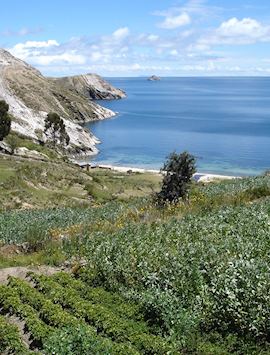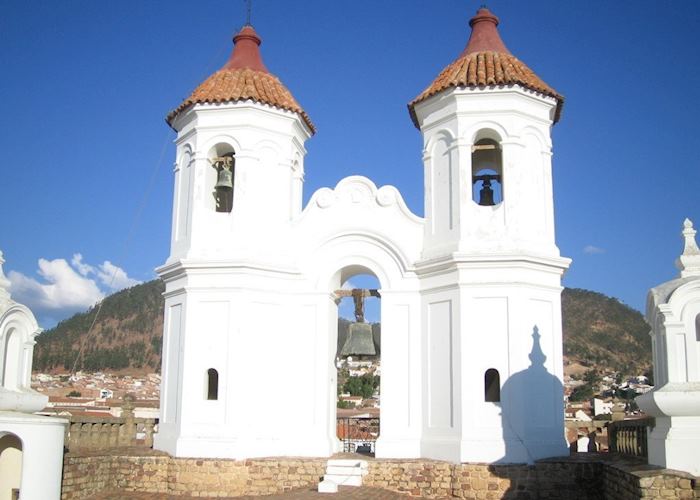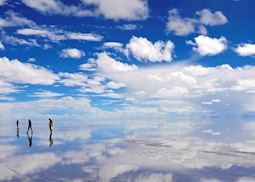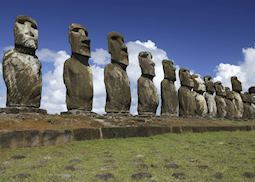
Bolivia is struggling to catch up to its Andean bedfellows Peru and Chile, and travel in this isolated land requires a relaxed and open mind. Yet, as our specialists will tell you, what Bolivia lacks in polish (and development), it makes up for in scenic splendor. The great white desert of the Salar de Uyuni salt flats is the first stop on most Bolivia vacations, and our specialists will show you how to explore it to the full. But they’ll also steer you toward the flamingo-haunted lagoons and mud geysers of the Southern Altiplano or the Amazonian savannah of Madidi National Park on your vacation to Bolivia.
Bolivia has a largely indigenous culture, whose lifestyle and crafts have survived Spanish conquistador rule and modern commerce. Our specialists can help you experience it all first-hand, from a visit to La Paz’s witches’ market to breaking bread with Lake Titicaca’s island communities.
Suggested tours for Bolivia
These tours give you a starting point for what your vacation to Bolivia could entail. Treat them as inspiration, as each trip is created uniquely for you.
Suggested activities for Bolivia
Whatever your interests, our specialists will build activities into your trip that connect to how you want to experience Bolivia.
-
Sun Island trekking ![Sun Island, Bolivia]()
Sun Island trekking
Lake TiticacaSun Island trekking
Sun Island is the perfect place to unwind and enjoy breathtaking views of Lake Titicaca. There are a number of small ruins and tiny traditional villages on the island but with no vehicles, getting about is restricted to walking some of the lovely trails or taking a boat.
View details -
Tiahuanaco ruins excursion ![Tiahuanaco, Bolivia]()
Tiahuanaco ruins excursion
La PazTiahuanaco ruins excursion
Tiwanaku was, during its splendor period, the largest city in the world and it is considered to be "the Cradle of the American Civilizations".
View details -
La Paz city tour ![Witches Market, La Paz]()
La Paz city tour
La PazLa Paz city tour
On this tour you have the opportunity to visit sights as diverse as the Witches' Market, where bowler-hatted local ladies sell everything from medicinal herbs to dried llama fetuses.
View details
Why travel with Audley?
- 100% tailor-made tours
- Fully protected travel
- Established for over 25 years
- 98% of our clients would recommend us
Best time to visit
Our specialists advise on the best months to visit Bolivia, including information about climate, events and festivals.
Request our brochure
Covering all seven continents, The World Your Way shows you how you can see the world with us. It features trip ideas from our specialists alongside hand-picked stays and experiences, and introduces our approach to creating meaningful travel experiences.

Useful information for planning your vacation in Bolivia
Spanish is the official language of Bolivia. In the highlands, you’ll hear the indigenous languages of Quechua and Aymara, too. English is rarely spoken.
The currency of Bolivia is the boliviano (Bs or BOB). You’ll find ATMs in all cities and larger towns, and Visa and Mastercard are quite widely accepted. Changing US dollars in banks is relatively easy but try to spend or exchange all your bolivianos before returning home as they’re virtually impossible to change outside of the country.
For the latest travel advice for Bolivia, including entry requirements, health information, and the safety and security situation, please refer to the State Department website.
In Bolivia, you should try salteñas (a pastry filled with meat and vegetables), sopa de mani (peanut soup), and anticuchos (grilled skewers of meat). In the lowlands, food is based around rice, yucca, and bananas, while in the highlands, you’ll find grains and potatoes often cooked with spicy stews or hot pepper sauces.
Other foods to look out for include mondongo (a pork dish spiced with chili and cumin), humita (corn cakes cooked in corn husks), and for something a little sweeter, pasteles de queso (a pastry filled with sweetened soft cheese).
You’ll find freshly squeezed juice sold on street corners and should try api morado (a purple corn drink with cinnamon, cloves, and orange) in the Altiplano.
You should tip around 10% at restaurants in Bolivia. Tipping drivers and tour guides is always appreciated but the amount is at your discretion.
In Bolivia, you can experience endless salt flats, towering mountains, lush jungles, and even a witches’ market. Driving through an enormous salt pan with a sea of white around you is one of the main reasons to visit Bolivia, but you’ll also be able to explore the Amazon Rainforest, visit traditional communities living on Lake Titicaca’s islands, or take a guided tour of La Paz.
You could also get out on foot to visit small villages, explore the otherworldly landscape of Valle de la Luna (Valley of the Moon), see flamingo-filled lagoons and mud geysers, or wander around pre-Columbia archaeological sites. Whether you’re interested in food, Indigenous culture, archaeology, or wildlife, you’ll find a huge range of things to see and do in Bolivia.
In Bolivia, you can stay in historical mansions, comfortable lodges, local guesthouses, or international hotels. Although the options for places to stay in Bolivia are more limited than in other South American countries, you’ll still find a good choice of hotels in La Paz, Santa Cruz, Sucre, and Lake Titicaca. In other areas, the options might be more basic, but we’ve chosen a selection of characterful family-run hotels and guesthouses in each location.
For example, you could stay in a simple salt hotel on the edge of the Salar de Uyuni, a small ecolodge in the Amazon Rainforest, a heritage hotel in Sucre, or a simple but interesting stay on the Altiplano. For further ideas, browse our collection of places to stay in Bolivia.
Bolivia is a large country offering a range of destinations but most visitors head for the Salar de Uyuni, Lake Titicaca, and La Paz. The main attraction for visitors to Bolivia is the vast salt flat of the Salar de Uyuni in the southwest, where a pool of water creates flawless reflections.
To the northwest, you’ll find La Paz, a bustling city set in a bowl-like canyon, and the glittering blue waters of Lake Titicaca where you can hike past Inca ruins and grazing llamas on Sun Island.
Further north is Madidi National Park where you can get into the Amazon Rainforest, while to the south, Sucre, Bolivia’s constitutional capital, offers ornate churches and the chance to visit small villages where weavers produce intricate textiles.
The best way to explore Bolivia’s salt flats is on a guided 4x4 trip. You can take a full-day trip across the salar from Uyuni or join a multi-day adventure that goes beyond the salar and into the Atacama Desert in Chile, passing curious sculpted rocks, vivid lakes, steaming fumaroles, and flamingo-filled lagoons along the way.
Bolivia’s incredible biodiversity makes it a great place to spot a wide range of wildlife. In the Amazon lowlands you might spot parrots, macaws, and hummingbirds, see pink river dolphins in the water, and if you’re lucky, elusive jaguars, pumas, or ocelots. Llamas, alpacas, and vicuñas roam the high plains and condors fly overhead, while in the national parks you could spot tapirs, capybaras, armadillos, spectacled bears, or sloths.
It takes around 11 hours to fly from the East Coast of the US to Bolivia, and from the West Coast it will take around 14 hours.
The time zone in Bolivia is UTC-4 hours. Daylight Savings Time is not used in Bolivia.
The best way to get around Bolivia is to use private drivers and internal flights. For long distances between main towns, we recommend flying as the roads aren’t always well maintained and the distances and altitude can make it tiring. For shorter distances, a driver-guide will get you where you need to go as efficiently as possible and offer an insight into the country and its people as you travel.
You can still travel to Bolivia in the wet season (November to March). Although you may find some delays on the roads, there’ll be far fewer visitors wherever you go, and mirror-like reflections on the salt flats near Uyuni.
The effects of the wet season are more obvious in the lowlands where roads into the jungle can turn to mud and the heat and humidity increase. In the Altiplano, the rains transform dry plains into lush grasslands, but muddy trails and cloud cover can make trekking more difficult and views less expansive.
A trip to Bolivia combines well with visits to Peru or Chile. For example, you could take an overland trip through Chile, Peru, and Bolivia which links Machu Picchu, the Salar de Uyuni, the Atacama Desert, and Eduardo Avaroa National Park.
Use our travel tool to find up-to-date visa and passport requirements for Bolivia. Enter where you’re traveling to and from (including any stopover destinations en route or flight layovers), along with your intended travel dates and passport details, for a full list of requirements.
Speak to your doctor for up-to-date advice on recommended vaccinations for travel to Bolivia. You can check suggested vaccinations on the Centers for Disease Control and Prevention website. It’s also a good idea to ensure you’re up to date with the recommended vaccinations for your home country.
As long as you rest on arrival and give your body time to acclimatize, you shouldn’t have any problems with the altitude in Bolivia.
Since the air is thinner at high altitudes you might initially experience headaches, fatigue, shortness of breath, nausea, or insomnia, so take it easy for the first few days and plan your trip so that the increase in altitude is gradual. Altitude affects everyone differently so listen to your body and if you continue to experience uncomfortable affects after a few days see a doctor or descend to lower altitudes.
Bolivia in pictures
Our expert guides to traveling in Bolivia
Written by our specialists from the viewpoint of their own travels, these guides will help you decide on the shape of your own trip to Bolivia. Aiming to inspire and inform, we share our recommendations for how to appreciate Bolivia at its best.
-
Machu Picchu plus one: tried-and-tested South American combinations ![Machu Picchu, Peru]()
Machu Picchu plus one: tried-and-tested South American combinations
Machu Picchu plus one: tried-and-tested South American combinations
Did you know that thanks to ever-improving flight connections, you can easily combine Machu Picchu with other South American destinations such as the Galapagos and Argentina — without the need to extend your trip drastically? Our specialists explain how.
Read this guide -
A path less trodden in Bolivia ![Salar de Uyuni, Bolivia]()
A path less trodden in Bolivia
A path less trodden in Bolivia
Bolivia is a less-known destination, but with many highlights to please the intrepid traveler, including the beautiful city of La Paz and the salt flats of Salar de Uyuni, there is plenty to explore.
Read this guide -
The Inca civilization ![Machu Picchu, Peru]()
The Inca civilization
The Inca civilization
Discover the culture and history of a country on a tailor-made trip, with visits to explore famous sites and others not quite so well known but equally impressive.
Read this guide





















